Swinburne University INF30020: City of Melbourne Risk Assessment
VerifiedAdded on 2022/10/13
|14
|2919
|12
Report
AI Summary
This report presents a comprehensive risk assessment of the City of Melbourne (CoM), focusing on its value creation activities and strategic context within the context of digital transformation. The report identifies key roles and responsibilities related to risk assessment within the organization. It thoroughly analyzes various risks, including those associated with operating in different countries (foreign exchange, political, and communication risks), operational risks (internal and external fraud, employee practices), accountability and transparency risks, marketing risks (price and sales risks), and transactional risks. The analysis includes a likelihood and impact assessment for each risk category, along with proposed mitigation processes. The report provides recommendations to improve CoM's risk and security management posture, offering a framework for enhancing the organization's resilience and ensuring the successful implementation of its digitalization initiatives.
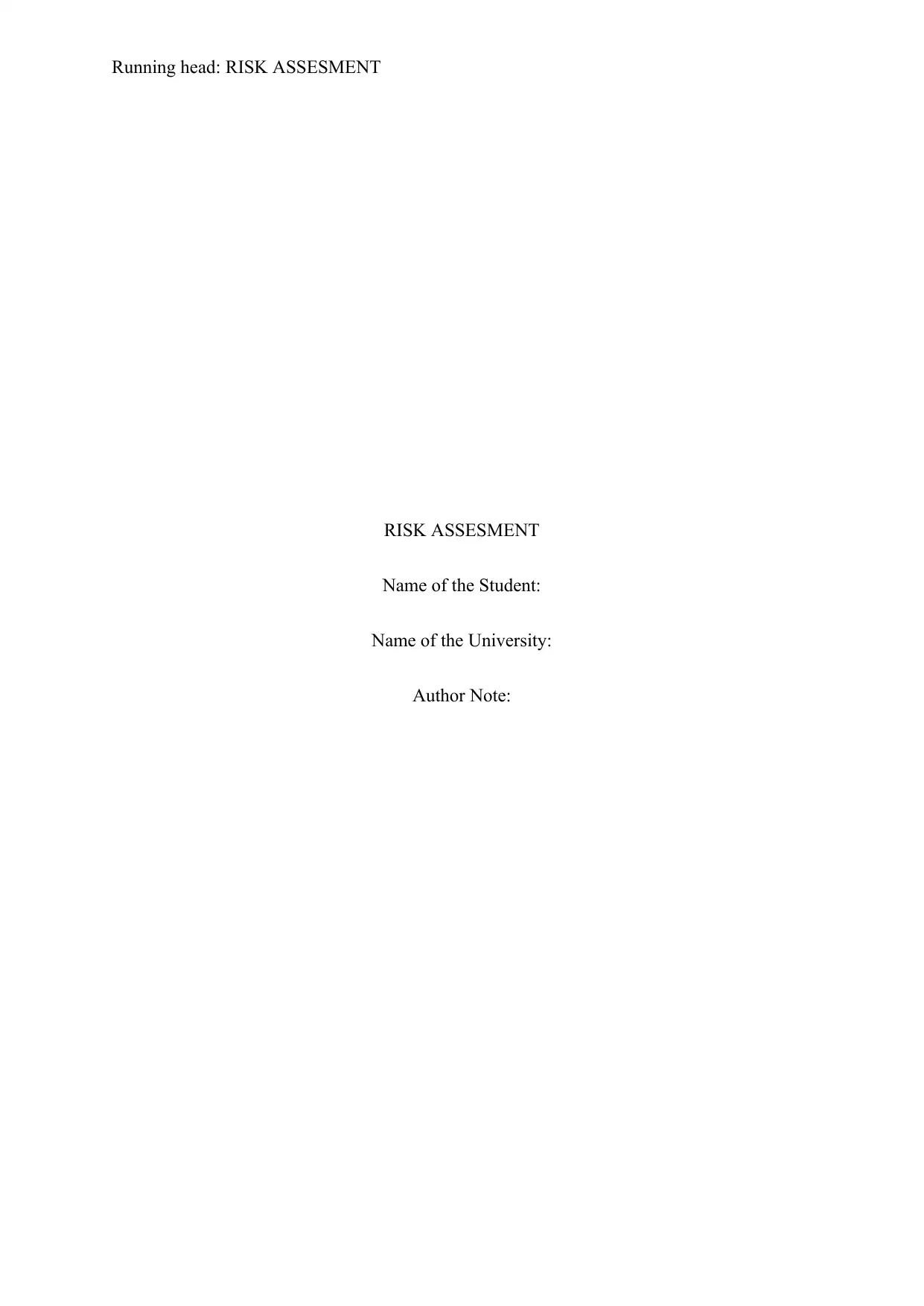
Running head: RISK ASSESMENT
RISK ASSESMENT
Name of the Student:
Name of the University:
Author Note:
RISK ASSESMENT
Name of the Student:
Name of the University:
Author Note:
Paraphrase This Document
Need a fresh take? Get an instant paraphrase of this document with our AI Paraphraser
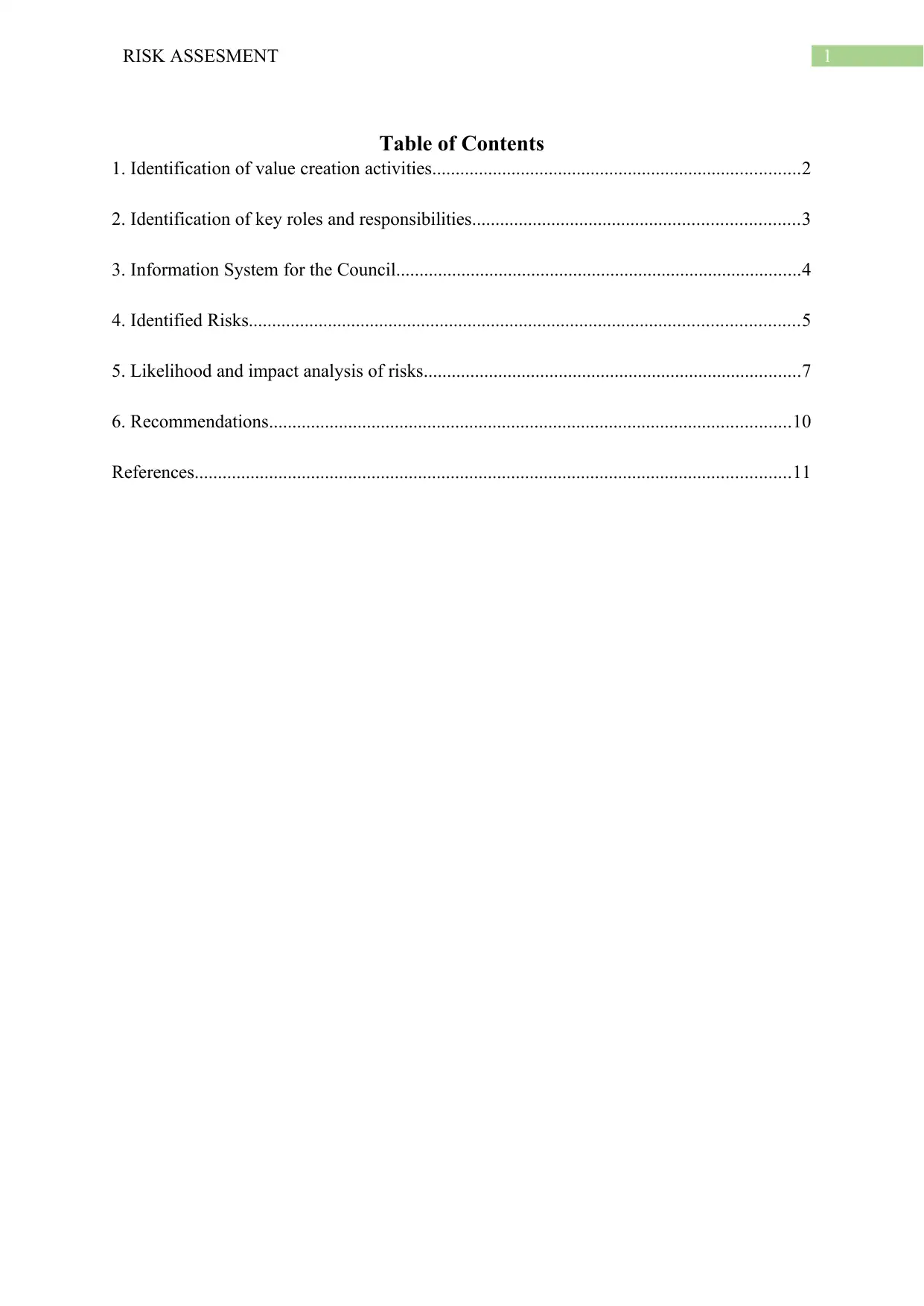
1RISK ASSESMENT
Table of Contents
1. Identification of value creation activities...............................................................................2
2. Identification of key roles and responsibilities......................................................................3
3. Information System for the Council.......................................................................................4
4. Identified Risks......................................................................................................................5
5. Likelihood and impact analysis of risks.................................................................................7
6. Recommendations................................................................................................................10
References................................................................................................................................11
Table of Contents
1. Identification of value creation activities...............................................................................2
2. Identification of key roles and responsibilities......................................................................3
3. Information System for the Council.......................................................................................4
4. Identified Risks......................................................................................................................5
5. Likelihood and impact analysis of risks.................................................................................7
6. Recommendations................................................................................................................10
References................................................................................................................................11
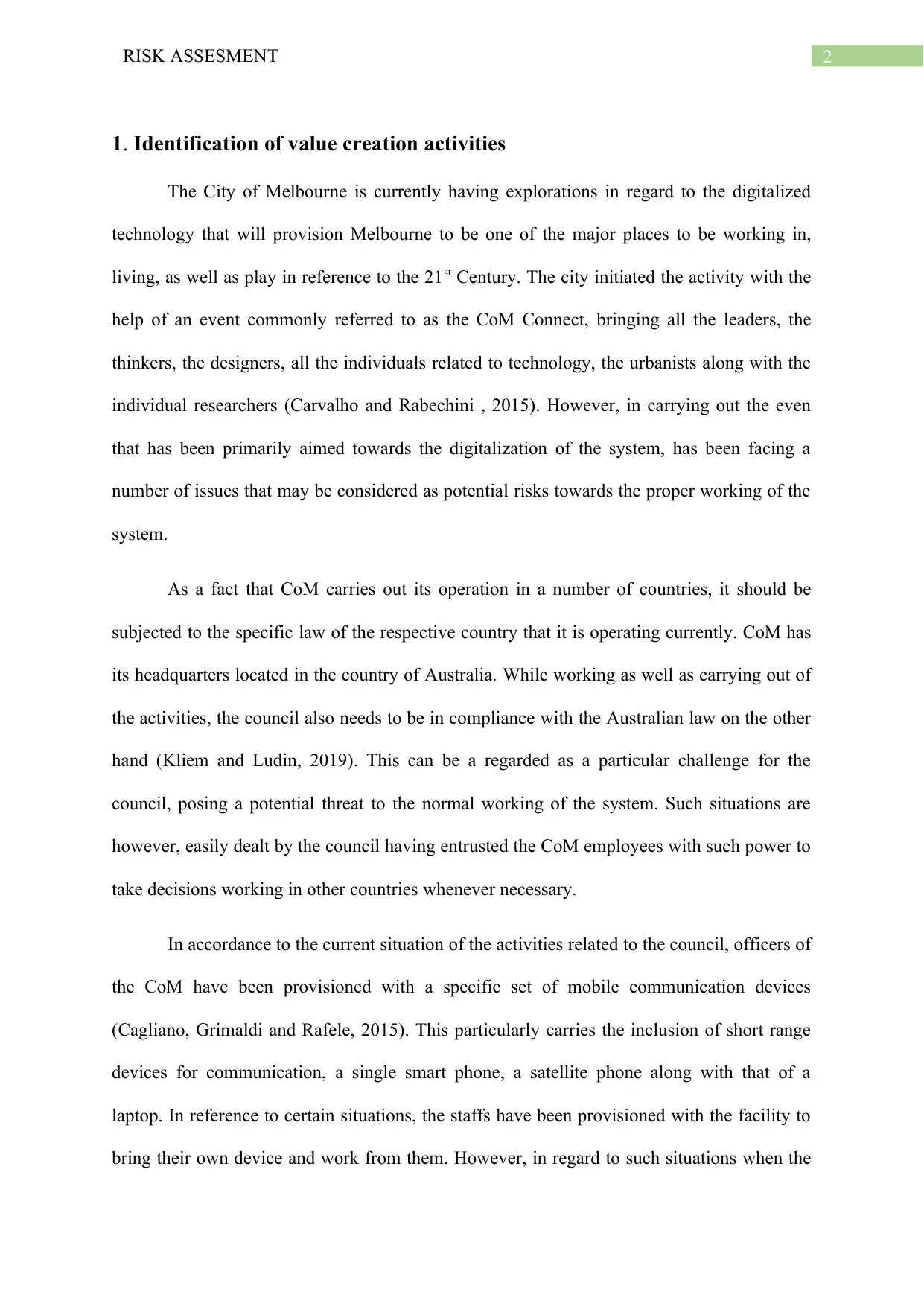
2RISK ASSESMENT
1. Identification of value creation activities
The City of Melbourne is currently having explorations in regard to the digitalized
technology that will provision Melbourne to be one of the major places to be working in,
living, as well as play in reference to the 21st Century. The city initiated the activity with the
help of an event commonly referred to as the CoM Connect, bringing all the leaders, the
thinkers, the designers, all the individuals related to technology, the urbanists along with the
individual researchers (Carvalho and Rabechini , 2015). However, in carrying out the even
that has been primarily aimed towards the digitalization of the system, has been facing a
number of issues that may be considered as potential risks towards the proper working of the
system.
As a fact that CoM carries out its operation in a number of countries, it should be
subjected to the specific law of the respective country that it is operating currently. CoM has
its headquarters located in the country of Australia. While working as well as carrying out of
the activities, the council also needs to be in compliance with the Australian law on the other
hand (Kliem and Ludin, 2019). This can be a regarded as a particular challenge for the
council, posing a potential threat to the normal working of the system. Such situations are
however, easily dealt by the council having entrusted the CoM employees with such power to
take decisions working in other countries whenever necessary.
In accordance to the current situation of the activities related to the council, officers of
the CoM have been provisioned with a specific set of mobile communication devices
(Cagliano, Grimaldi and Rafele, 2015). This particularly carries the inclusion of short range
devices for communication, a single smart phone, a satellite phone along with that of a
laptop. In reference to certain situations, the staffs have been provisioned with the facility to
bring their own device and work from them. However, in regard to such situations when the
1. Identification of value creation activities
The City of Melbourne is currently having explorations in regard to the digitalized
technology that will provision Melbourne to be one of the major places to be working in,
living, as well as play in reference to the 21st Century. The city initiated the activity with the
help of an event commonly referred to as the CoM Connect, bringing all the leaders, the
thinkers, the designers, all the individuals related to technology, the urbanists along with the
individual researchers (Carvalho and Rabechini , 2015). However, in carrying out the even
that has been primarily aimed towards the digitalization of the system, has been facing a
number of issues that may be considered as potential risks towards the proper working of the
system.
As a fact that CoM carries out its operation in a number of countries, it should be
subjected to the specific law of the respective country that it is operating currently. CoM has
its headquarters located in the country of Australia. While working as well as carrying out of
the activities, the council also needs to be in compliance with the Australian law on the other
hand (Kliem and Ludin, 2019). This can be a regarded as a particular challenge for the
council, posing a potential threat to the normal working of the system. Such situations are
however, easily dealt by the council having entrusted the CoM employees with such power to
take decisions working in other countries whenever necessary.
In accordance to the current situation of the activities related to the council, officers of
the CoM have been provisioned with a specific set of mobile communication devices
(Cagliano, Grimaldi and Rafele, 2015). This particularly carries the inclusion of short range
devices for communication, a single smart phone, a satellite phone along with that of a
laptop. In reference to certain situations, the staffs have been provisioned with the facility to
bring their own device and work from them. However, in regard to such situations when the
⊘ This is a preview!⊘
Do you want full access?
Subscribe today to unlock all pages.

Trusted by 1+ million students worldwide
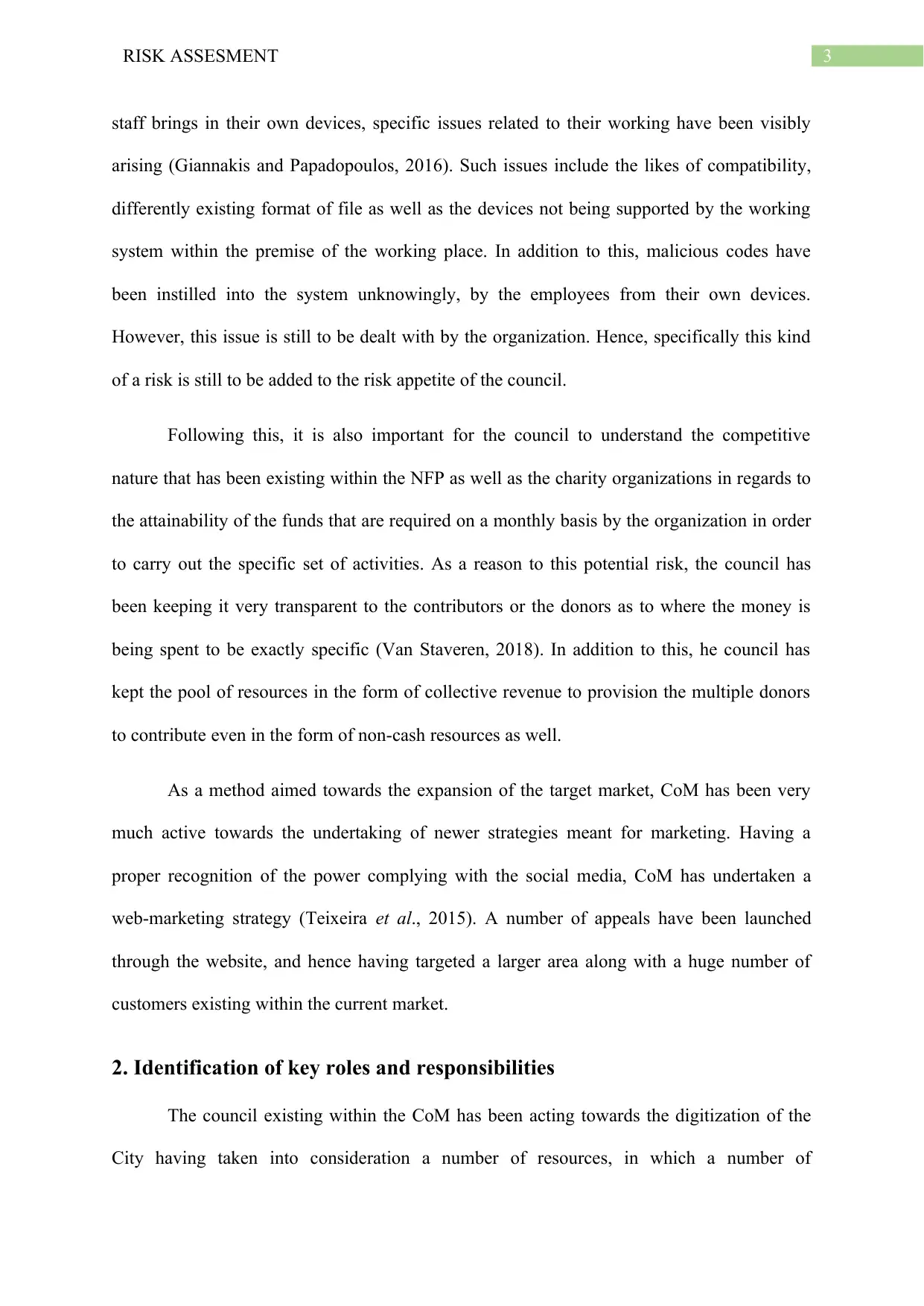
3RISK ASSESMENT
staff brings in their own devices, specific issues related to their working have been visibly
arising (Giannakis and Papadopoulos, 2016). Such issues include the likes of compatibility,
differently existing format of file as well as the devices not being supported by the working
system within the premise of the working place. In addition to this, malicious codes have
been instilled into the system unknowingly, by the employees from their own devices.
However, this issue is still to be dealt with by the organization. Hence, specifically this kind
of a risk is still to be added to the risk appetite of the council.
Following this, it is also important for the council to understand the competitive
nature that has been existing within the NFP as well as the charity organizations in regards to
the attainability of the funds that are required on a monthly basis by the organization in order
to carry out the specific set of activities. As a reason to this potential risk, the council has
been keeping it very transparent to the contributors or the donors as to where the money is
being spent to be exactly specific (Van Staveren, 2018). In addition to this, he council has
kept the pool of resources in the form of collective revenue to provision the multiple donors
to contribute even in the form of non-cash resources as well.
As a method aimed towards the expansion of the target market, CoM has been very
much active towards the undertaking of newer strategies meant for marketing. Having a
proper recognition of the power complying with the social media, CoM has undertaken a
web-marketing strategy (Teixeira et al., 2015). A number of appeals have been launched
through the website, and hence having targeted a larger area along with a huge number of
customers existing within the current market.
2. Identification of key roles and responsibilities
The council existing within the CoM has been acting towards the digitization of the
City having taken into consideration a number of resources, in which a number of
staff brings in their own devices, specific issues related to their working have been visibly
arising (Giannakis and Papadopoulos, 2016). Such issues include the likes of compatibility,
differently existing format of file as well as the devices not being supported by the working
system within the premise of the working place. In addition to this, malicious codes have
been instilled into the system unknowingly, by the employees from their own devices.
However, this issue is still to be dealt with by the organization. Hence, specifically this kind
of a risk is still to be added to the risk appetite of the council.
Following this, it is also important for the council to understand the competitive
nature that has been existing within the NFP as well as the charity organizations in regards to
the attainability of the funds that are required on a monthly basis by the organization in order
to carry out the specific set of activities. As a reason to this potential risk, the council has
been keeping it very transparent to the contributors or the donors as to where the money is
being spent to be exactly specific (Van Staveren, 2018). In addition to this, he council has
kept the pool of resources in the form of collective revenue to provision the multiple donors
to contribute even in the form of non-cash resources as well.
As a method aimed towards the expansion of the target market, CoM has been very
much active towards the undertaking of newer strategies meant for marketing. Having a
proper recognition of the power complying with the social media, CoM has undertaken a
web-marketing strategy (Teixeira et al., 2015). A number of appeals have been launched
through the website, and hence having targeted a larger area along with a huge number of
customers existing within the current market.
2. Identification of key roles and responsibilities
The council existing within the CoM has been acting towards the digitization of the
City having taken into consideration a number of resources, in which a number of
Paraphrase This Document
Need a fresh take? Get an instant paraphrase of this document with our AI Paraphraser
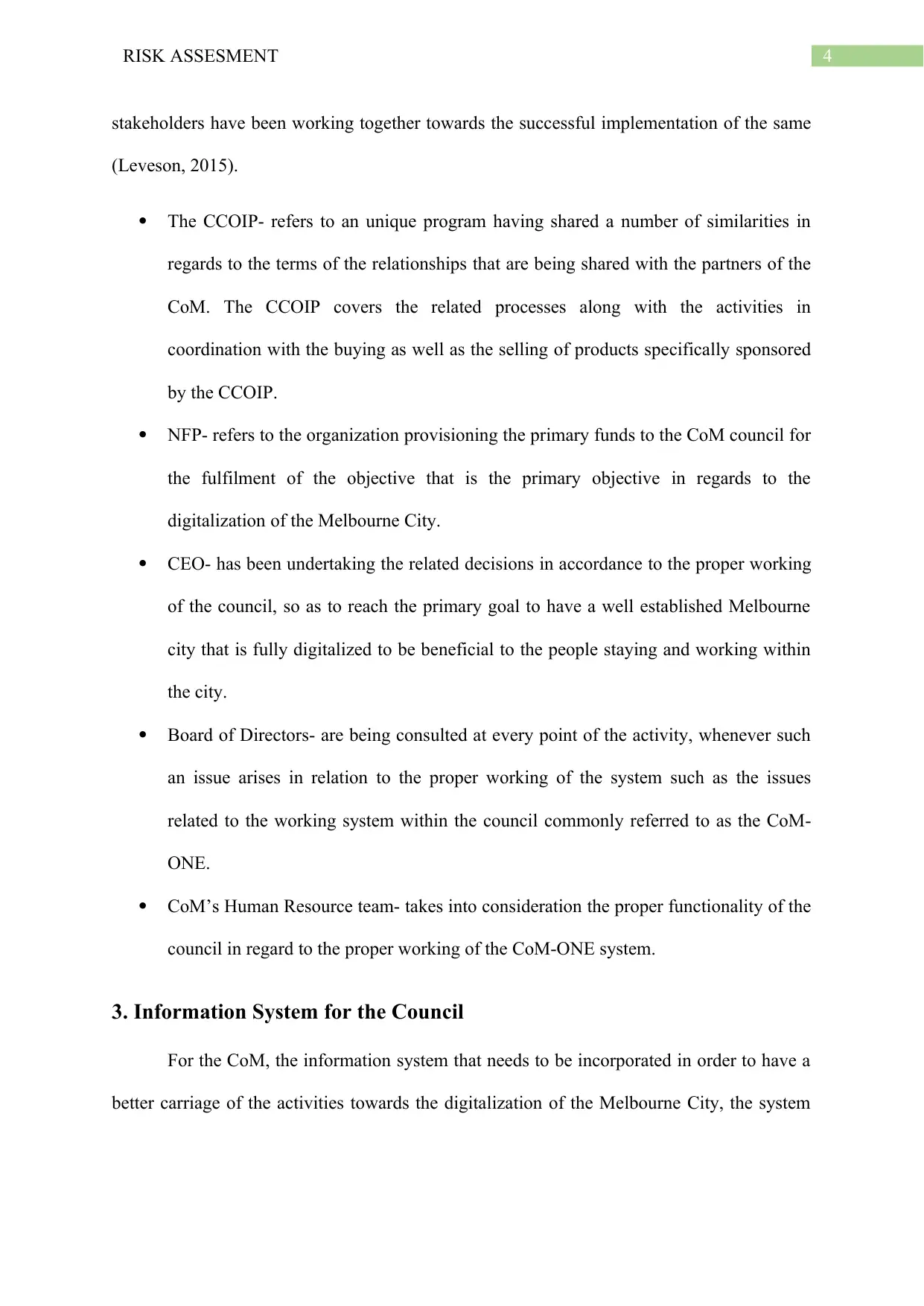
4RISK ASSESMENT
stakeholders have been working together towards the successful implementation of the same
(Leveson, 2015).
The CCOIP- refers to an unique program having shared a number of similarities in
regards to the terms of the relationships that are being shared with the partners of the
CoM. The CCOIP covers the related processes along with the activities in
coordination with the buying as well as the selling of products specifically sponsored
by the CCOIP.
NFP- refers to the organization provisioning the primary funds to the CoM council for
the fulfilment of the objective that is the primary objective in regards to the
digitalization of the Melbourne City.
CEO- has been undertaking the related decisions in accordance to the proper working
of the council, so as to reach the primary goal to have a well established Melbourne
city that is fully digitalized to be beneficial to the people staying and working within
the city.
Board of Directors- are being consulted at every point of the activity, whenever such
an issue arises in relation to the proper working of the system such as the issues
related to the working system within the council commonly referred to as the CoM-
ONE.
CoM’s Human Resource team- takes into consideration the proper functionality of the
council in regard to the proper working of the CoM-ONE system.
3. Information System for the Council
For the CoM, the information system that needs to be incorporated in order to have a
better carriage of the activities towards the digitalization of the Melbourne City, the system
stakeholders have been working together towards the successful implementation of the same
(Leveson, 2015).
The CCOIP- refers to an unique program having shared a number of similarities in
regards to the terms of the relationships that are being shared with the partners of the
CoM. The CCOIP covers the related processes along with the activities in
coordination with the buying as well as the selling of products specifically sponsored
by the CCOIP.
NFP- refers to the organization provisioning the primary funds to the CoM council for
the fulfilment of the objective that is the primary objective in regards to the
digitalization of the Melbourne City.
CEO- has been undertaking the related decisions in accordance to the proper working
of the council, so as to reach the primary goal to have a well established Melbourne
city that is fully digitalized to be beneficial to the people staying and working within
the city.
Board of Directors- are being consulted at every point of the activity, whenever such
an issue arises in relation to the proper working of the system such as the issues
related to the working system within the council commonly referred to as the CoM-
ONE.
CoM’s Human Resource team- takes into consideration the proper functionality of the
council in regard to the proper working of the CoM-ONE system.
3. Information System for the Council
For the CoM, the information system that needs to be incorporated in order to have a
better carriage of the activities towards the digitalization of the Melbourne City, the system
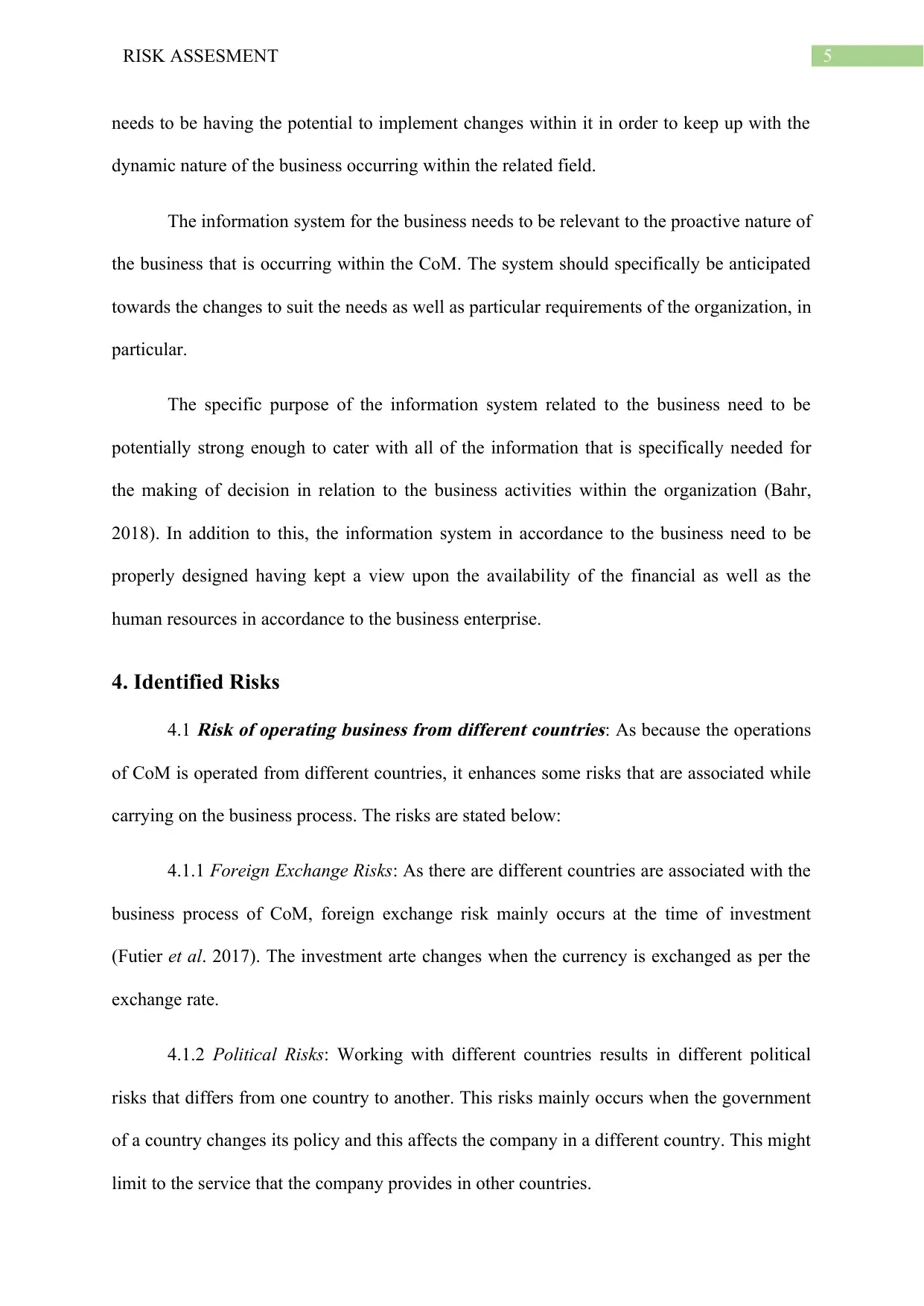
5RISK ASSESMENT
needs to be having the potential to implement changes within it in order to keep up with the
dynamic nature of the business occurring within the related field.
The information system for the business needs to be relevant to the proactive nature of
the business that is occurring within the CoM. The system should specifically be anticipated
towards the changes to suit the needs as well as particular requirements of the organization, in
particular.
The specific purpose of the information system related to the business need to be
potentially strong enough to cater with all of the information that is specifically needed for
the making of decision in relation to the business activities within the organization (Bahr,
2018). In addition to this, the information system in accordance to the business need to be
properly designed having kept a view upon the availability of the financial as well as the
human resources in accordance to the business enterprise.
4. Identified Risks
4.1
Risk of operating business from different countries: As because the operations
of CoM is operated from different countries, it enhances some risks that are associated while
carrying on the business process. The risks are stated below:
4.1.1 Foreign Exchange Risks: As there are different countries are associated with the
business process of CoM, foreign exchange risk mainly occurs at the time of investment
(Futier et al. 2017). The investment arte changes when the currency is exchanged as per the
exchange rate.
4.1.2 Political Risks: Working with different countries results in different political
risks that differs from one country to another. This risks mainly occurs when the government
of a country changes its policy and this affects the company in a different country. This might
limit to the service that the company provides in other countries.
needs to be having the potential to implement changes within it in order to keep up with the
dynamic nature of the business occurring within the related field.
The information system for the business needs to be relevant to the proactive nature of
the business that is occurring within the CoM. The system should specifically be anticipated
towards the changes to suit the needs as well as particular requirements of the organization, in
particular.
The specific purpose of the information system related to the business need to be
potentially strong enough to cater with all of the information that is specifically needed for
the making of decision in relation to the business activities within the organization (Bahr,
2018). In addition to this, the information system in accordance to the business need to be
properly designed having kept a view upon the availability of the financial as well as the
human resources in accordance to the business enterprise.
4. Identified Risks
4.1
Risk of operating business from different countries: As because the operations
of CoM is operated from different countries, it enhances some risks that are associated while
carrying on the business process. The risks are stated below:
4.1.1 Foreign Exchange Risks: As there are different countries are associated with the
business process of CoM, foreign exchange risk mainly occurs at the time of investment
(Futier et al. 2017). The investment arte changes when the currency is exchanged as per the
exchange rate.
4.1.2 Political Risks: Working with different countries results in different political
risks that differs from one country to another. This risks mainly occurs when the government
of a country changes its policy and this affects the company in a different country. This might
limit to the service that the company provides in other countries.
⊘ This is a preview!⊘
Do you want full access?
Subscribe today to unlock all pages.

Trusted by 1+ million students worldwide
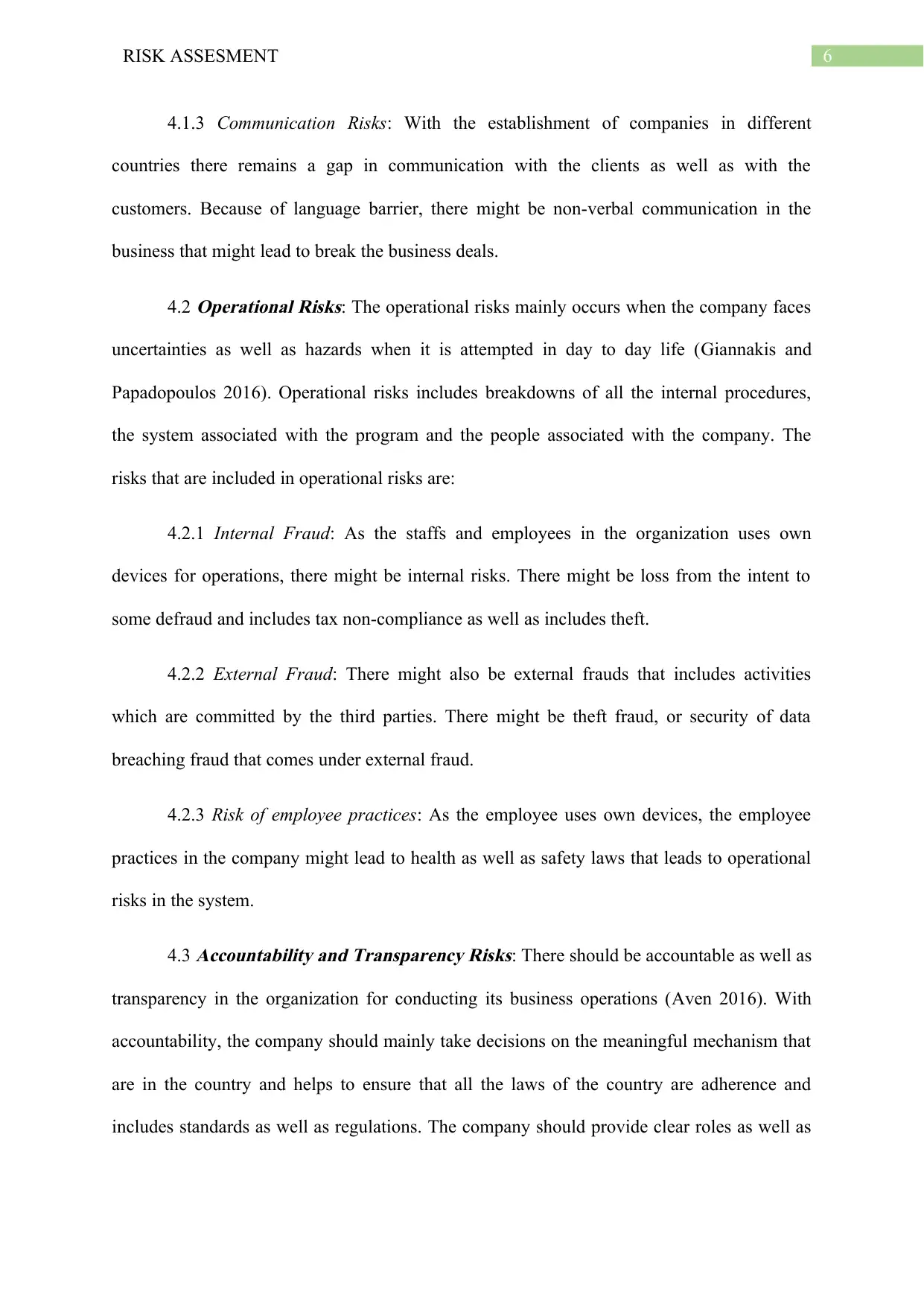
6RISK ASSESMENT
4.1.3 Communication Risks: With the establishment of companies in different
countries there remains a gap in communication with the clients as well as with the
customers. Because of language barrier, there might be non-verbal communication in the
business that might lead to break the business deals.
4.2
Operational Risks: The operational risks mainly occurs when the company faces
uncertainties as well as hazards when it is attempted in day to day life (Giannakis and
Papadopoulos 2016). Operational risks includes breakdowns of all the internal procedures,
the system associated with the program and the people associated with the company. The
risks that are included in operational risks are:
4.2.1 Internal Fraud: As the staffs and employees in the organization uses own
devices for operations, there might be internal risks. There might be loss from the intent to
some defraud and includes tax non-compliance as well as includes theft.
4.2.2 External Fraud: There might also be external frauds that includes activities
which are committed by the third parties. There might be theft fraud, or security of data
breaching fraud that comes under external fraud.
4.2.3 Risk of employee practices: As the employee uses own devices, the employee
practices in the company might lead to health as well as safety laws that leads to operational
risks in the system.
4.3
Accountability and Transparency Risks: There should be accountable as well as
transparency in the organization for conducting its business operations (Aven 2016). With
accountability, the company should mainly take decisions on the meaningful mechanism that
are in the country and helps to ensure that all the laws of the country are adherence and
includes standards as well as regulations. The company should provide clear roles as well as
4.1.3 Communication Risks: With the establishment of companies in different
countries there remains a gap in communication with the clients as well as with the
customers. Because of language barrier, there might be non-verbal communication in the
business that might lead to break the business deals.
4.2
Operational Risks: The operational risks mainly occurs when the company faces
uncertainties as well as hazards when it is attempted in day to day life (Giannakis and
Papadopoulos 2016). Operational risks includes breakdowns of all the internal procedures,
the system associated with the program and the people associated with the company. The
risks that are included in operational risks are:
4.2.1 Internal Fraud: As the staffs and employees in the organization uses own
devices for operations, there might be internal risks. There might be loss from the intent to
some defraud and includes tax non-compliance as well as includes theft.
4.2.2 External Fraud: There might also be external frauds that includes activities
which are committed by the third parties. There might be theft fraud, or security of data
breaching fraud that comes under external fraud.
4.2.3 Risk of employee practices: As the employee uses own devices, the employee
practices in the company might lead to health as well as safety laws that leads to operational
risks in the system.
4.3
Accountability and Transparency Risks: There should be accountable as well as
transparency in the organization for conducting its business operations (Aven 2016). With
accountability, the company should mainly take decisions on the meaningful mechanism that
are in the country and helps to ensure that all the laws of the country are adherence and
includes standards as well as regulations. The company should provide clear roles as well as
Paraphrase This Document
Need a fresh take? Get an instant paraphrase of this document with our AI Paraphraser
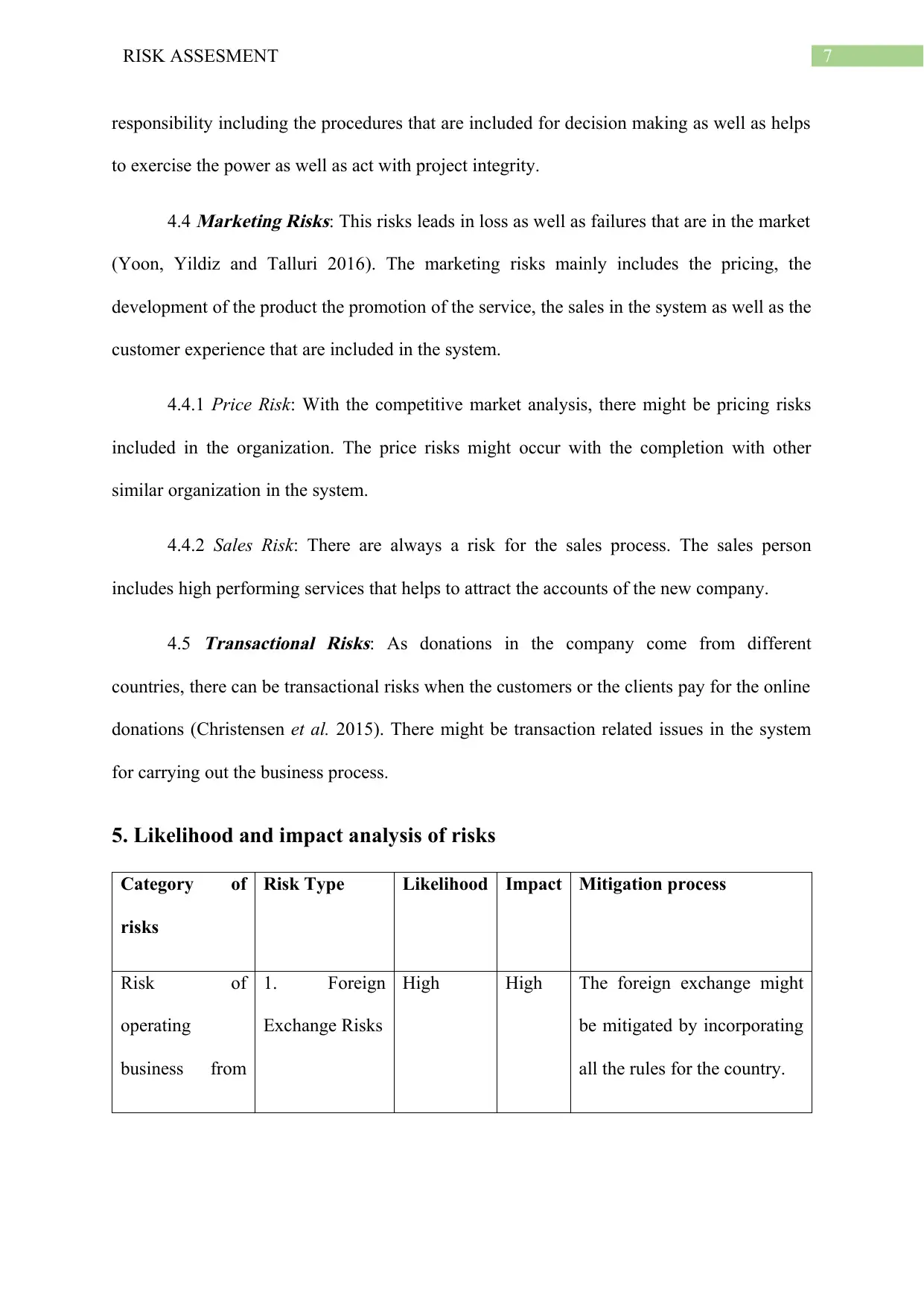
7RISK ASSESMENT
responsibility including the procedures that are included for decision making as well as helps
to exercise the power as well as act with project integrity.
4.4
Marketing Risks: This risks leads in loss as well as failures that are in the market
(Yoon, Yildiz and Talluri 2016). The marketing risks mainly includes the pricing, the
development of the product the promotion of the service, the sales in the system as well as the
customer experience that are included in the system.
4.4.1 Price Risk: With the competitive market analysis, there might be pricing risks
included in the organization. The price risks might occur with the completion with other
similar organization in the system.
4.4.2 Sales Risk: There are always a risk for the sales process. The sales person
includes high performing services that helps to attract the accounts of the new company.
4.5
Transactional Risks: As donations in the company come from different
countries, there can be transactional risks when the customers or the clients pay for the online
donations (Christensen et al. 2015). There might be transaction related issues in the system
for carrying out the business process.
5. Likelihood and impact analysis of risks
Category of
risks
Risk Type Likelihood Impact Mitigation process
Risk of
operating
business from
1. Foreign
Exchange Risks
High High The foreign exchange might
be mitigated by incorporating
all the rules for the country.
responsibility including the procedures that are included for decision making as well as helps
to exercise the power as well as act with project integrity.
4.4
Marketing Risks: This risks leads in loss as well as failures that are in the market
(Yoon, Yildiz and Talluri 2016). The marketing risks mainly includes the pricing, the
development of the product the promotion of the service, the sales in the system as well as the
customer experience that are included in the system.
4.4.1 Price Risk: With the competitive market analysis, there might be pricing risks
included in the organization. The price risks might occur with the completion with other
similar organization in the system.
4.4.2 Sales Risk: There are always a risk for the sales process. The sales person
includes high performing services that helps to attract the accounts of the new company.
4.5
Transactional Risks: As donations in the company come from different
countries, there can be transactional risks when the customers or the clients pay for the online
donations (Christensen et al. 2015). There might be transaction related issues in the system
for carrying out the business process.
5. Likelihood and impact analysis of risks
Category of
risks
Risk Type Likelihood Impact Mitigation process
Risk of
operating
business from
1. Foreign
Exchange Risks
High High The foreign exchange might
be mitigated by incorporating
all the rules for the country.
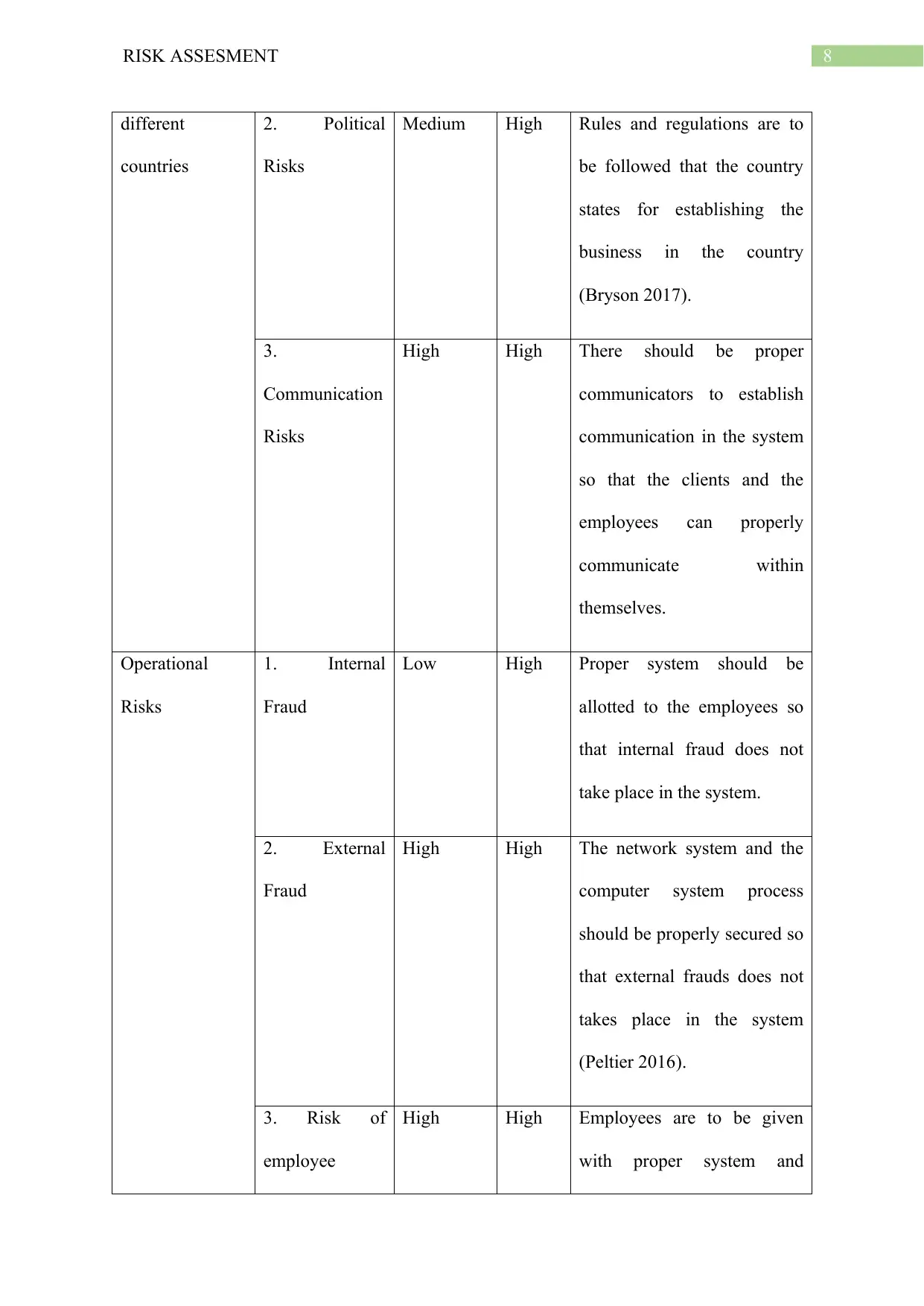
8RISK ASSESMENT
different
countries
2. Political
Risks
Medium High Rules and regulations are to
be followed that the country
states for establishing the
business in the country
(Bryson 2017).
3.
Communication
Risks
High High There should be proper
communicators to establish
communication in the system
so that the clients and the
employees can properly
communicate within
themselves.
Operational
Risks
1. Internal
Fraud
Low High Proper system should be
allotted to the employees so
that internal fraud does not
take place in the system.
2. External
Fraud
High High The network system and the
computer system process
should be properly secured so
that external frauds does not
takes place in the system
(Peltier 2016).
3. Risk of
employee
High High Employees are to be given
with proper system and
different
countries
2. Political
Risks
Medium High Rules and regulations are to
be followed that the country
states for establishing the
business in the country
(Bryson 2017).
3.
Communication
Risks
High High There should be proper
communicators to establish
communication in the system
so that the clients and the
employees can properly
communicate within
themselves.
Operational
Risks
1. Internal
Fraud
Low High Proper system should be
allotted to the employees so
that internal fraud does not
take place in the system.
2. External
Fraud
High High The network system and the
computer system process
should be properly secured so
that external frauds does not
takes place in the system
(Peltier 2016).
3. Risk of
employee
High High Employees are to be given
with proper system and
⊘ This is a preview!⊘
Do you want full access?
Subscribe today to unlock all pages.

Trusted by 1+ million students worldwide
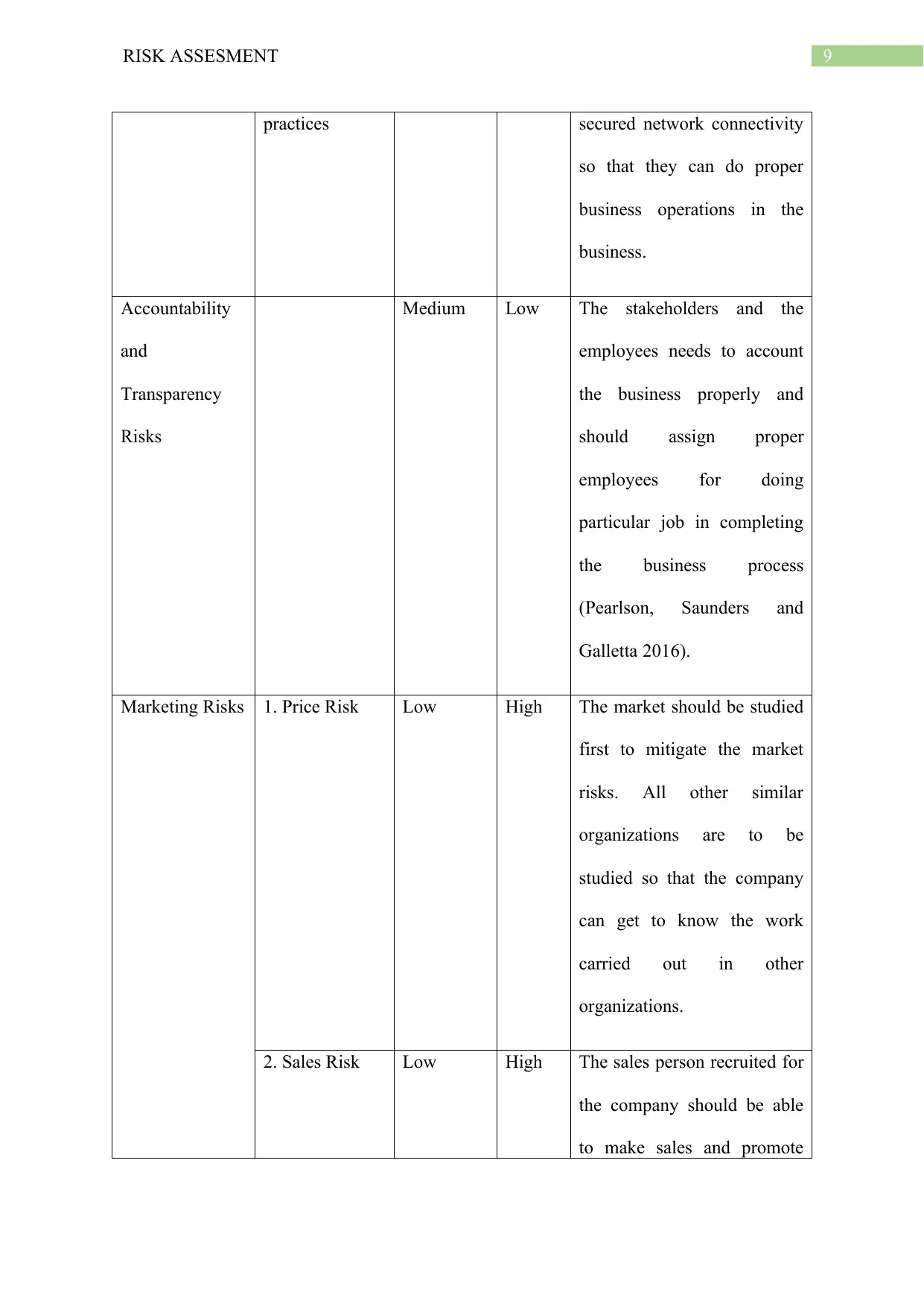
9RISK ASSESMENT
practices secured network connectivity
so that they can do proper
business operations in the
business.
Accountability
and
Transparency
Risks
Medium Low The stakeholders and the
employees needs to account
the business properly and
should assign proper
employees for doing
particular job in completing
the business process
(Pearlson, Saunders and
Galletta 2016).
Marketing Risks 1. Price Risk Low High The market should be studied
first to mitigate the market
risks. All other similar
organizations are to be
studied so that the company
can get to know the work
carried out in other
organizations.
2. Sales Risk Low High The sales person recruited for
the company should be able
to make sales and promote
practices secured network connectivity
so that they can do proper
business operations in the
business.
Accountability
and
Transparency
Risks
Medium Low The stakeholders and the
employees needs to account
the business properly and
should assign proper
employees for doing
particular job in completing
the business process
(Pearlson, Saunders and
Galletta 2016).
Marketing Risks 1. Price Risk Low High The market should be studied
first to mitigate the market
risks. All other similar
organizations are to be
studied so that the company
can get to know the work
carried out in other
organizations.
2. Sales Risk Low High The sales person recruited for
the company should be able
to make sales and promote
Paraphrase This Document
Need a fresh take? Get an instant paraphrase of this document with our AI Paraphraser
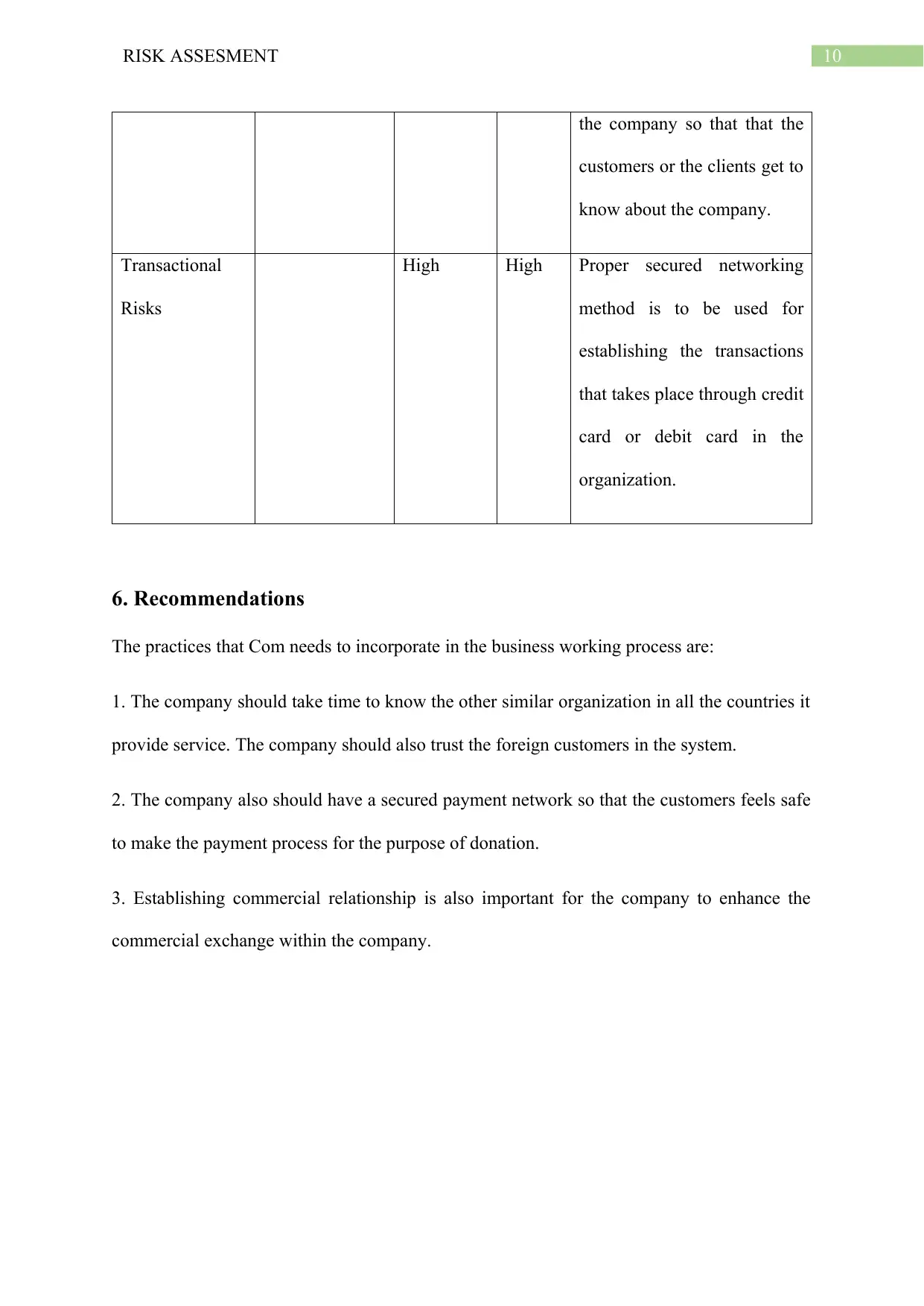
10RISK ASSESMENT
the company so that that the
customers or the clients get to
know about the company.
Transactional
Risks
High High Proper secured networking
method is to be used for
establishing the transactions
that takes place through credit
card or debit card in the
organization.
6. Recommendations
The practices that Com needs to incorporate in the business working process are:
1. The company should take time to know the other similar organization in all the countries it
provide service. The company should also trust the foreign customers in the system.
2. The company also should have a secured payment network so that the customers feels safe
to make the payment process for the purpose of donation.
3. Establishing commercial relationship is also important for the company to enhance the
commercial exchange within the company.
the company so that that the
customers or the clients get to
know about the company.
Transactional
Risks
High High Proper secured networking
method is to be used for
establishing the transactions
that takes place through credit
card or debit card in the
organization.
6. Recommendations
The practices that Com needs to incorporate in the business working process are:
1. The company should take time to know the other similar organization in all the countries it
provide service. The company should also trust the foreign customers in the system.
2. The company also should have a secured payment network so that the customers feels safe
to make the payment process for the purpose of donation.
3. Establishing commercial relationship is also important for the company to enhance the
commercial exchange within the company.

11RISK ASSESMENT
⊘ This is a preview!⊘
Do you want full access?
Subscribe today to unlock all pages.

Trusted by 1+ million students worldwide
1 out of 14
Related Documents
Your All-in-One AI-Powered Toolkit for Academic Success.
+13062052269
info@desklib.com
Available 24*7 on WhatsApp / Email
![[object Object]](/_next/static/media/star-bottom.7253800d.svg)
Unlock your academic potential
Copyright © 2020–2025 A2Z Services. All Rights Reserved. Developed and managed by ZUCOL.





